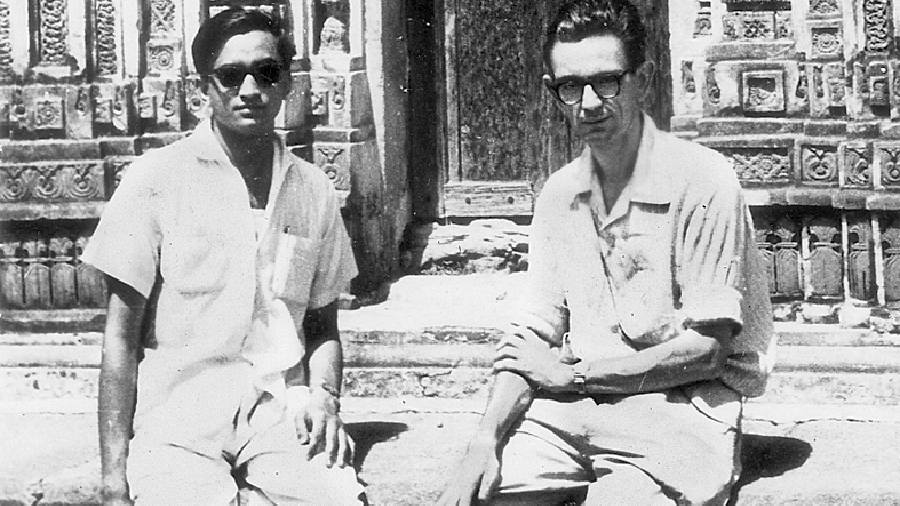In his introduction to Hiteshranjan Sanyal’s book titled Bangla Kirtaner Itihas (The History of Bangla Kirtan) published posthumously in 1989, scholar Gautam Bhadra had written of the distinguished social historian, who died young at 48, a year before the book saw the light of day: “…For the past three decades he has explored various subjects, his spirit of inquiry pervades writing about the history of the nationalist movement in rural Bengal, looking for the wellspring of the various conventions of regional architecture and sculpture, analysing the social implications of Gandhian philosophy or the history of Vaishnavism.”
On November 19, a website that was created by the Centre for Studies in Social Sciences Calcutta (CSSSC) titled Religious Architecture of Bengal, a multi-faceted web-resource featuring photographs and documentation of Bengal’s religious architecture by Sanyal, was launched.
Sanyal, born in Salop, Pabna, in former East Bengal, was faculty at the CSSSC from 1973 till his death. He graduated from St Paul’s College, Kolkata.
He had participated in the excavation of the Chandraketugarh archaeological site, and in the early 1970s had travelled extensively in south-western Bengal collecting a wealth of material for his thesis, Temple-Building Activities in Bengal: A Social Study, 1450-1900.
Besides his friend, David McCutchion (1930-1972), the Scotsman who is remembered for his photographic documentation over 12 years of Bengal’s terracotta temples, Sanyal was accompanied by such stalwarts as Tarapada Santra (1931-2003), Dipak Ranjan Das and Daniel Thorner.

Jor-Bangla temple, Bishnupur, Bankura, constructed in 1655, photographed by Hiteshranjan Sanyal
The address of this voluminous and rare photographic web archive of Bengal’s history is religiousarchitecturebengal.cssscal.org. It was created by Kamalika Mukherjee and Sujaan Mukherjee, CSSSC-based archivists and researchers. Manaswita Sanyal, Hiteshranjan’s widow, had handed over materials for the archive to CSSSC in 2000.
In the 1960s, Sanyal systematically documented Bengal’s unique regional school of temple architecture in about 3,000 photographs, close to 1,500 of which were uploaded. The terracotta and laterite temples dating back to the period between 17th and 19th centuries used the chala and ratna stylistic forms and offered a wealth of figural sculpture and ornamentation. Some forms and materials influenced the regions’ mosque architecture. The temple sculpture reflected the changing political and social mores of the region.
At the inauguration of the website at CSSSC’s Jadunath Bhavan Museum & Resource Centre, Bhadra praised the “beautiful design” of the website and added that Sanyal was “thoroughly committed” and there was no way of understanding him without understanding the leading anthropologist Nirmal Kumar Bose.
On his methodology, Bhadra said Sanyal would first identify a temple, identify an icon, and identify the inscription on the temple. He would document its present condition and try to find out its earlier condition. Sanyal encouraged the documentation of local and regional history by non-academics and establishment of local museums.
According to the press release, “Sanyal’s photographs show high levels of perception and precision, with a broad spectrum of shots taken from various angles that offer valuable information on the structures and embellishments.”
Cataloguing and digitisation of the photographs began in 2003-2004. The archive says: “The archive has been built keeping in mind different queries that users may ask of the collection. Apart from temple names, villages, and districts, the search function can also be used to locate specific motifs.... Users may also choose to search specific collections, i.e. districts or temples, or narrow down their searches to specific fields of the metadata.” It has an interactive map as well.
The CSSSC has in its possession 200 photographs of David McCutchion as well, which could not be uploaded for copyright reasons. McCutchion had bequeathed his entire collection to the Victoria & Albert Museum, London.
The website ultimately aims to incorporate or connect with other photograph collections of Bengal’s religious architecture like those of McCutchion, Tarapada Santra and George Michell.
